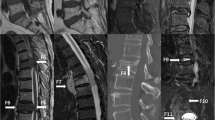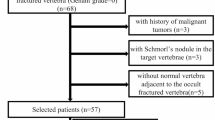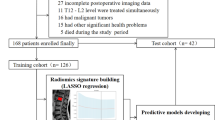Abstract
Purpose
To evaluate the diagnostic performance of bone texture analysis (TA) combined with machine learning (ML) algorithms in standard CT scans to identify patients with vertebrae at risk for insufficiency fractures.
Materials and methods
Standard CT scans of 58 patients with insufficiency fractures of the spine, performed between 2006 and 2013, were analyzed retrospectively. Every included patient had at least two CT scans. Intact vertebrae in a first scan that either fractured (“unstable”) or remained intact (“stable”) in the consecutive scan were manually segmented on mid-sagittal reformations. TA features for all vertebrae were extracted using open-source software (MaZda). In a paired control study, all vertebrae of the study cohort “cases” and matched controls were classified using ROC analysis of Hounsfield unit (HU) measurements and supervised ML techniques. In a within-subject vertebra comparison, vertebrae of the cases were classified into “unstable” and “stable” using identical techniques.
Results
One hundred twenty vertebrae were included. Classification of cases/controls using ROC analysis of HU measurements showed an AUC of 0.83 (95% confidence interval [CI], 0.77–0.88), and ML-based classification showed an AUC of 0.97 (CI, 0.97–0.98). Classification of unstable/stable vertebrae using ROC analysis showed an AUC of 0.52 (CI, 0.42–0.63), and ML-based classification showed an AUC of 0.64 (CI, 0.61–0.67).
Conclusion
TA combined with ML allows to identifying patients who will suffer from vertebral insufficiency fractures in standard CT scans with high accuracy. However, identification of single vertebra at risk remains challenging.
Key Points
• Bone texture analysis combined with machine learning allows to identify patients at risk for vertebral body insufficiency fractures on standard CT scans with high accuracy.
• Compared to mere Hounsfield unit measurements on CT scans, application of bone texture analysis combined with machine learning improve fracture risk prediction.
• This analysis has the potential to identify vertebrae at risk for insufficiency fracture and may thus increase diagnostic value of standard CT scans.






Similar content being viewed by others
Abbreviations
- ANN:
-
Artificial neural networks
- BMD:
-
Bone mineral density
- CCC:
-
Concordance correlation coefficient
- DXA:
-
Dual-energy X-ray absorptiometry
- FEA:
-
Finite element analysis
- GLCM:
-
Gray-level co-occurrence matrix
- GLRLM:
-
Gray-level run-length matrix
- HR-pQCT:
-
High-resolution peripheral quantitative computed tomography
- IH:
-
Image histogram
- ML:
-
Machine learning
- MLP:
-
Multi-layer perceptron
- RF:
-
Random forest
- ROI:
-
Region of interest
- SVM:
-
Support vector machine
- TA:
-
Texture analysis
- TLJ:
-
Thoracic-lumbar junction
References
Sambrook P, Cooper C (2006) Osteoporosis. Lancet 367:2010–2018. https://doi.org/10.1016/S0140-6736(06)68891-0
Kim DH, Vaccaro AR (2006) Osteoporotic compression fractures of the spine; current options and considerations for treatment. Spine J 6:479–487. https://doi.org/10.1016/j.spinee.2006.04.013
NIH Consensus Development Panel on Osteoporosis Prevention, Diagnosis, and Therapy (2001) Osteoporosis prevention, diagnosis, and therapy. JAMA 285:785–795. https://doi.org/10.1001/jama.285.6.785
Johnell O, Kanis JA (2006) An estimate of the worldwide prevalence and disability associated with osteoporotic fractures. Osteoporos Int 17:1726–1733. https://doi.org/10.1007/s00198-006-0172-4
Johnell O, Kanis J (2005) Epidemiology of osteoporotic fractures. Osteoporos Int 16:S3–S7. https://doi.org/10.1007/s00198-004-1702-6
Delmas PD, van de Langerijt L, Watts NB et al (2005) Underdiagnosis of vertebral fractures is a worldwide problem: the IMPACT study. J Bone Miner Res 20:557–563. https://doi.org/10.1359/JBMR.041214
Silva BC, Leslie WD, Resch H et al (2014) Trabecular bone score: a noninvasive analytical method based upon the DXA image. J Bone Miner Res 29:518–530. https://doi.org/10.1002/jbmr.2176
Burns JE, Yao J, Summers RM (2017) Vertebral body compression fractures and bone density: automated detection and classification on CT images. Radiology 284:788–797. https://doi.org/10.1148/radiol.2017162100
Schreiber JJ, Anderson PA, Rosas HG, Buchholz AL, Au AG (2011) Hounsfield units for assessing bone mineral density and strength: a tool for osteoporosis management. J Bone Joint Surg 93:1057–1063. https://doi.org/10.2106/JBJS.J.00160
Krug R, Burghardt AJ, Majumdar S, Link TM (2010) High-resolution imaging techniques for the assessment of osteoporosis. Radiol Clin North Am 48:601–621. https://doi.org/10.1016/j.rcl.2010.02.015
Damilakis J, Maris TG, Karantanas AH (2007) An update on the assessment of osteoporosis using radiologic techniques. Eur Radiol 17:1591–1602. https://doi.org/10.1007/s00330-006-0511-z
Imai K, Ohnishi I, Bessho M, Nakamura K (2006) Nonlinear finite element model predicts vertebral bone strength and fracture site. Spine (Phila Pa 1976) 31:1789–1794
Schwaiger BJ, Kopperdahl DL, Nardo L et al (2017) Vertebral and femoral bone mineral density and bone strength in prostate cancer patients assessed in phantomless PET/CT examinations. Bone 101:62–69. https://doi.org/10.1016/j.bone.2017.04.008
Lubner MG, Smith AD, Sandrasegaran K, Sahani DV, Pickhardt PJ (2017) CT texture analysis: definitions, applications, biologic correlates, and challenges. Radiographics 37:1483–1503. https://doi.org/10.1148/rg.2017170056
Rachidi M, Marchadier A, Gadois C, Lespessailles E, Chappard C, Benhamou CL (2008) Laws’ masks descriptors applied to bone texture analysis: an innovative and discriminant tool in osteoporosis. Skeletal Radiol 37:541–548. https://doi.org/10.1007/s00256-008-0463-2
Thevenot J, Hirvasniemi J, Pulkkinen P et al (2014) Assessment of risk of femoral neck fracture with radiographic texture parameters: a retrospective study. Radiology 272:184–191
Zou Z, Yang J, Megalooikonomou V, Jennane R, Cheng E, Ling H (2016) Trabecular bone texture classification using wavelet leaders. Proc. SPIE 9788, Medical Imaging 2016: Biomedical Applications in Molecular, Structural, and Functional Imaging, 97880E. https://doi.org/10.1117/12.2216452
Mannil M, Eberhard M, Becker AS et al (2017) Normative values for CT-based texture analysis of vertebral bodies in dual X-ray absorptiometry-confirmed, normally mineralized subjects. Skeletal Radiol 46:1541–1551. https://doi.org/10.1007/s00256-017-2728-0
Tabari A, Torriani M, Miller KK, Klibanski A, Kalra MK, Bredella MA (2016) Anorexia nervosa: analysis of trabecular texture with CT. Radiology 283:178–185
Torres C, Hammond I (2016) Computed tomography and magnetic resonance imaging in the differentiation of osteoporotic fractures from neoplastic metastatic fractures. J Clin Densitom 19:63–69. https://doi.org/10.1016/j.jocd.2015.08.008
Genant HK, Wu CY, van Kuijk C, Nevitt MC (2009) Vertebral fracture assessment using a semiquantitative technique. J Bone Miner Res 8:1137–1148. https://doi.org/10.1002/jbmr.5650080915
Szczypiński PM, Strzelecki M, Materka A, Klepaczko A (2009) MaZda—a software package for image texture analysis. Comput Methods Programs Biomed 94:66–76. https://doi.org/10.1016/j.cmpb.2008.08.005
Andresen R, Radmer S, Banzer D (1998) Bone mineral density and spongiosa architecture in correlation to vertebral body insufficiency fractures. Acta Radiol 39:538–542
Ito M, Ikeda K, Nishiguchi M et al (2005) Multi-detector row CT imaging of vertebral microstructure for evaluation of fracture risk. J Bone Miner Res 20:1828–1836. https://doi.org/10.1359/JBMR.050610
Issever AS, Link TM, Kentenich M et al (2010) Assessment of trabecular bone structure using MDCT: comparison of 64- and 320-slice CT using HR-pQCT as the reference standard. Eur Radiol 20:458–468. https://doi.org/10.1007/s00330-009-1571-7
Kuhn M (2008) Building predictive models in R using the caret package. J Stat Softw 28. https://doi.org/10.18637/jss.v028.i05
Gevrey M, Dimopoulos I, Lek S (2003) Review and comparison of methods to study the contribution of variables in artificial neural network models. Ecol Modell 160:249–264
DeLong ER, DeLong DM, Clarke-Pearson DL (1988) Comparing the areas under two or more correlated receiver operating characteristic curves: a nonparametric approach. Biometrics 44:837–845
Lin LI-K (1989) A concordance correlation coefficient to evaluate reproducibility. Biometrics 45:255–268. https://doi.org/10.2307/2532051
Erickson BJ, Korfiatis P, Akkus Z, Kline TL (2017) Machine learning for medical imaging. Radiographics 37:505–515. https://doi.org/10.1148/rg.2017160130
Valentinitsch A, Patsch J, Mueller D et al (2010) Texture analysis in quantitative osteoporosis assessment. In: Biomedical imaging: from nano to macro, 2010 IEEE International Symposium on. IEEE, pp 1361–1364
Boivin GY, Chavassieux PM, Santora AC, Yates J, Meunier PJ (2000) Alendronate increases bone strength by increasing the mean degree of mineralization of bone tissue in osteoporotic women. Bone 27:687–694
Guggenbuhl P, Bodic F, Hamel L, Baslé MF, Chappard D (2006) Texture analysis of X-ray radiographs of iliac bone is correlated with bone micro-CT. Osteoporos Int 17:447–454. https://doi.org/10.1007/s00198-005-0007-8
Chappard D, Guggenbuhl P, Legrand E, Baslé MF, Audran M (2005) Texture analysis of X-ray radiographs is correlated with bone histomorphometry. J Bone Miner Metab 23:24–29. https://doi.org/10.1007/s00774-004-0536-9
Kimmel DB, Recker RR, Gallagher JC, Vaswani AS, Aloia JF (1990) A comparison of iliac bone histomorphometric data in post-menopausal osteoporotic and normal subjects. Bone Miner 11:217–235
Reddy TK, Kumaravel N (2010) Wavelet based texture analysis and classification of bone lesions from dental CT. Int J Med Eng Inf 2:319–327
Rohlmann A, Zander T, Bergmann G (2006) Spinal loads after osteoporotic vertebral fractures treated by vertebroplasty or kyphoplasty. Eur Spine J 15:1255–1264. https://doi.org/10.1007/s00586-005-0018-3
Paul R, Alahamri S, Malla S, Quadri GJ (2017) Make your bone great again: a study on osteoporosis classification. Available via http://arxiv.org/abs/1707.05385. Accessed 02 Jan 2018
Wagner S, Stäbler A, Sittek H et al (2005) Diagnosis of osteoporosis: visual assessment on conventional versus digital radiographs. Osteoporos Int 16:1815–1822. https://doi.org/10.1007/s00198-005-1937-x
Ngo VQ, Dinh TN (2016) Bone texture characterization based on Contourlet and Gabor tranforms. Int J Comput Theory Eng 8:177–181. https://doi.org/10.7763/IJCTE.2016.V8.1040
Funding
The authors state that this work has not received any funding.
Author information
Authors and Affiliations
Corresponding author
Ethics declarations
Guarantor
The scientific guarantor of this publication is Roman Guggenberger.
Conflict of interest
The authors of this manuscript declare no relationships with any companies, whose products or services may be related to the subject matter of the article.
Statistics and biometry
One of the authors has significant statistical expertise.
Informed consent
Written informed consent was waived by the Institutional Review Board.
Ethical approval
Institutional Review Board approval was obtained.
Study subjects or cohorts overlap
The control cohort used in the present study (58 patients) is part of a study population of a previously published study establishing normative values for CT-based texture analysis of vertebral bodies. Mannil M, Eberhard M, Becker AS, et al (2017) Normative values for CT-based texture analysis of vertebral bodies in dual X-ray absorptiometry-confirmed, normally mineralized subjects. Skeletal Radiology 46:1541–1551. https://doi.org/10.1007/s00256-017-2728-0).
Methodology
• retrospective
• case-control study
• performed at one institution
Electronic supplementary material
ESM 1
(DOCX 20 kb)
Rights and permissions
About this article
Cite this article
Muehlematter, U.J., Mannil, M., Becker, A.S. et al. Vertebral body insufficiency fractures: detection of vertebrae at risk on standard CT images using texture analysis and machine learning. Eur Radiol 29, 2207–2217 (2019). https://doi.org/10.1007/s00330-018-5846-8
Received:
Revised:
Accepted:
Published:
Issue Date:
DOI: https://doi.org/10.1007/s00330-018-5846-8




